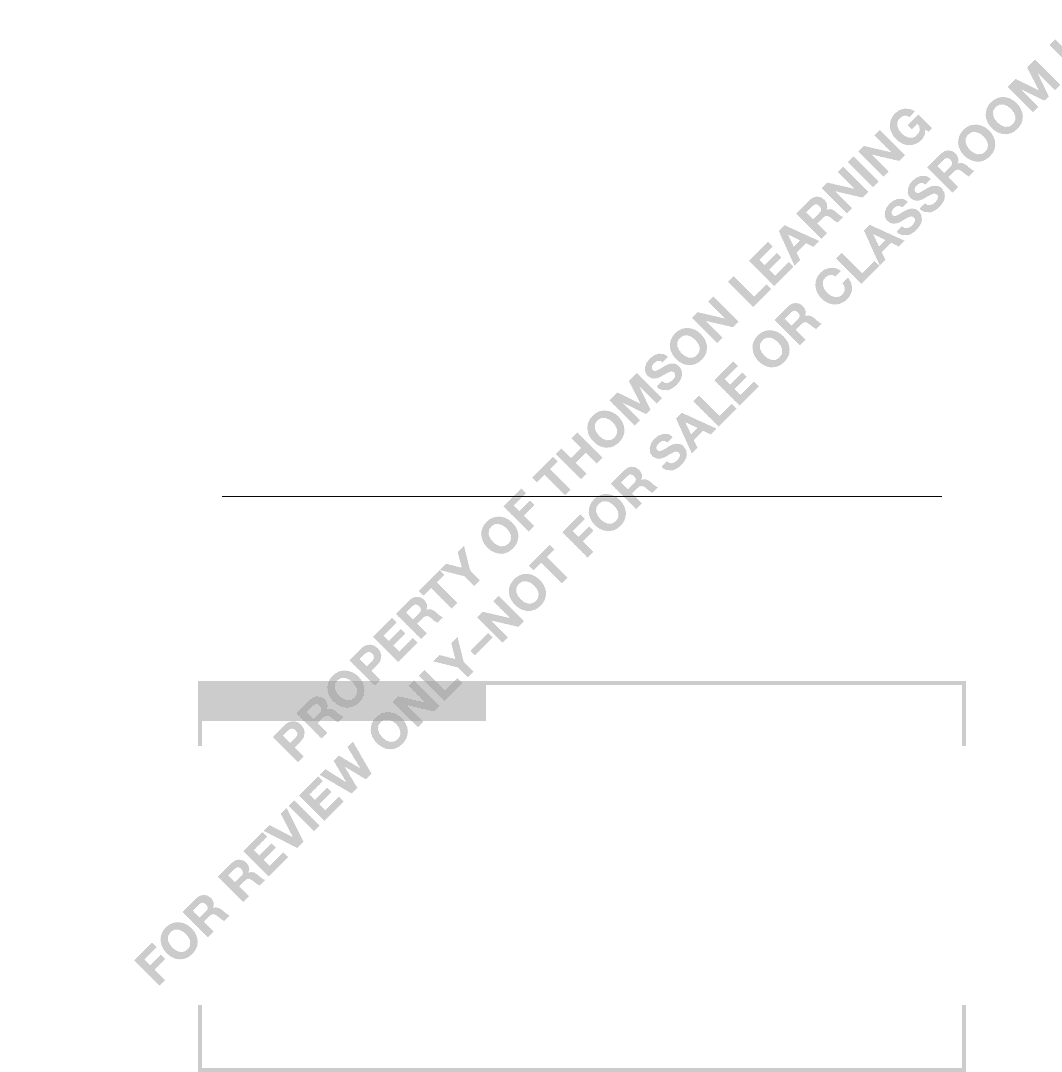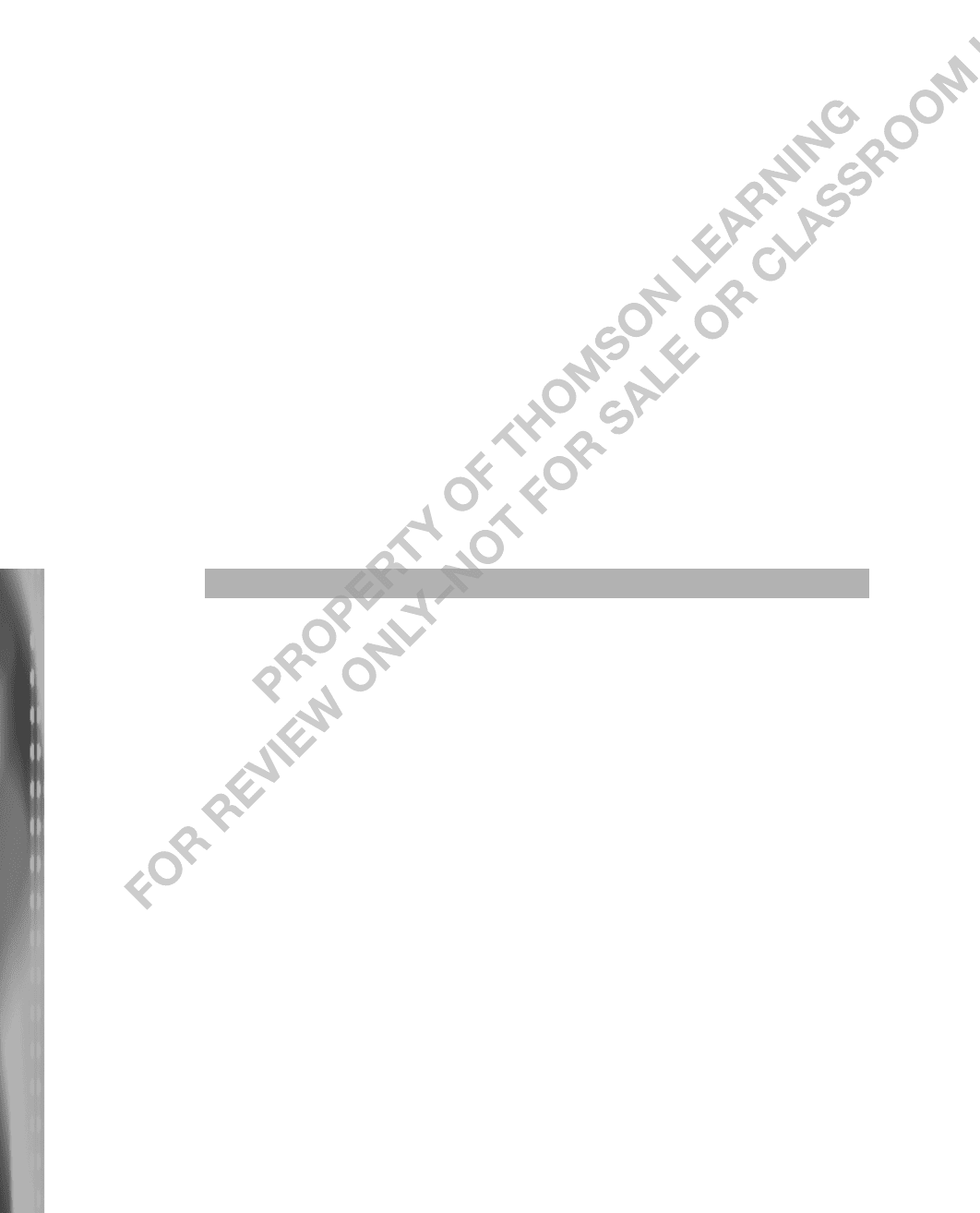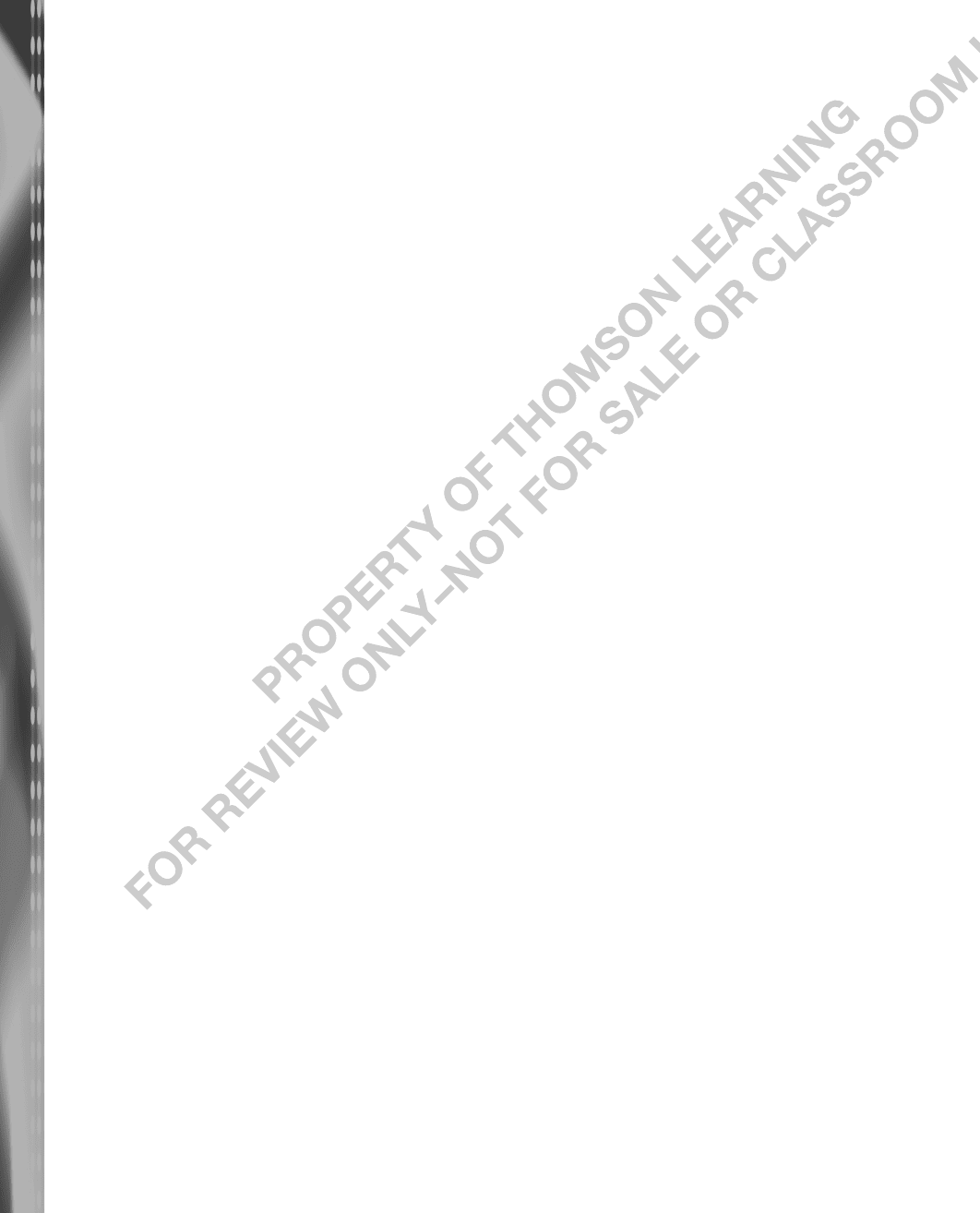Wooldridge J. Introductory Econometrics: A Modern Approach (Basic Text - 3d ed.)
Подождите немного. Документ загружается.


15.7 Applying 2SLS to Time Series Equations
When we apply 2SLS to time series data, many of the considerations that arose for OLS in
Chapters 10, 11, and 12 are relevant. Write the structural equation for each time period as
y
t
0
1
x
t1
…
k
x
tk
u
t
, (15.52)
where one or more of the explanatory variables x
tj
might be correlated with u
t
. Denote the
set of exogenous variables by z
t1
,…,z
tm
:
E(u
t
) 0, Cov(z
tj
,u
t
) 0, j 1, …, m.
Any exogenous explanatory variable is also a z
tj
. For identification, it is necessary that
m k (we have as many exogenous variables as explanatory variables).
The mechanics of 2SLS are identical for time series or cross-sectional data, but for
time series data the statistical properties of 2SLS depend on the trending and correlation
properties of the underlying sequences. In particular, we must be careful to include trends
if we have trending dependent or explana-
tory variables. Since a time trend is exoge-
nous, it can always serve as its own instru-
mental variable. The same is true of
seasonal dummy variables, if monthly or
quarterly data are used.
Series that have strong persistence
(have unit roots) must be used with care,
just as with OLS. Often, differencing the
equation is warranted before estimation,
and this applies to the instruments as well.
Under analogs of the assumptions in
Chapter 11 for the asymptotic properties of
OLS, 2SLS using time series data is con-
sistent and asymptotically normally distributed. In fact, if we replace the explanatory vari-
ables with the instrumental variables in stating the assumptions, we only need to add the
identification assumptions for 2SLS. For example, the homoskedasticity assumption is
stated as
E(u
t
2
z
t1
,…,z
tm
)
2
, (15.53)
and the no serial correlation assumption is stated as
E(u
t
u
s
z
t
,z
s
) 0, for all t s, (15.54)
where z
t
denotes all exogenous variables at time t. A full statement of the assumptions is
given in the chapter appendix. We will provide examples of 2SLS for time series prob-
lems in Chapter 16; see also Computer Exercise C15.4.
536 Part 3 Advanced Topics
A model to test the effect of growth in government spending on
growth in output is
gGDP
t
0
1
gGOV
t
2
INVRAT
t
3
gLAB
t
u
t
,
where g indicates growth, GDP is real gross domestic product,
GOV is real government spending, INVRAT is the ratio of gross
domestic investment to GDP, and LAB is the size of the labor force.
[See equation (6) in Ram (1986).] Under what assumptions would
a dummy variable indicating whether the president in year t 1
is a Republican be a suitable IV for gGOV
t
?
QUESTION 15.4

As in the case of OLS, the no serial correlation assumption can often be violated with
time series data. Fortunately, it is very easy to test for AR(1) serial correlation. If we write
u
t
u
t1
e
t
and plug this into equation (15.52), we get
y
t
0
1
x
t1
…
k
x
tk
u
t1
e
t
, t 2. (15.55)
To test H
0
:
1
0, we must replace u
t1
with the 2SLS residuals, u
ˆ
t1
. Further, if x
tj
is
endogenous in (15.52), then it is endogenous in (15.55), so we still need to use an IV.
Because e
t
is uncorrelated with all past values of u
t
, u
ˆ
t1
can be used as its own instrument.
TESTING FOR AR(1) SERIAL CORRELATION AFTER 2SLS:
(i) Estimate (15.52) by 2SLS and obtain the 2SLS residuals, u
ˆ
t
.
(ii) Estimate
y
t
0
1
x
t1
…
k
x
tk
u
ˆ
t1
error
t
, t 2, …, n
by 2SLS, using the same instruments from part (i), in addition to u
ˆ
t1
. Use the t statistic
on
ˆ
to test H
0
:
0.
As with the OLS version of this test from Chapter 12, the t statistic only has asymp-
totic justification, but it tends to work well in practice. A heteroskedasticity-robust version
can be used to guard against heteroskedasticity. Further, lagged residuals can be added to
the equation to test for higher forms of serial correlation using a joint F test.
What happens if we detect serial correlation? Some econometrics packages will com-
pute standard errors that are robust to fairly general forms of serial correlation and het-
eroskedasticity. This is a nice, simple way to go if your econometrics package does this.
The computations are very similar to those in Section 12.5 for OLS. See Wooldridge
(1995) for formulas and other computational methods.
An alternative is to use the AR(1) model and correct for serial correlation. The proce-
dure is similar to that for OLS and places additional restrictions on the instrumental vari-
ables. The quasi-differenced equation is the same as in equation (12.32):
y
˜
t
0
(1
)
1
x
˜
t1
…
k
x
˜
tk
e
t
, t 2, (15.56)
where x
˜
tj
x
tj
x
t1,j
. (We can use the t 1 observation just as in Section 12.3, but
we omit that for simplicity here.) The question is: What can we use as instrumental vari-
ables? It seems natural to use the quasi-differenced instruments, z
˜
tj
z
tj
z
t1,j
. This
only works, however, if in (15.52) the original error u
t
is uncorrelated with the instruments
at times t, t 1, and t 1. That is, the instrumental variables must be strictly exogenous
in (15.52). This rules out lagged dependent variables as IVs, for example. It also elimi-
nates cases where future movements in the IVs react to current and past changes in the
error, u
t
.
2SLS WITH AR(1) ERRORS:
(i) Estimate (15.52) by 2SLS and obtain the 2SLS residuals, u
ˆ
t
, t 1,2, …, n.
Chapter 15 Instrumental Variables Estimation and Two Stage Least Squares 537

(ii) Obtain
ˆ
from the regression of u
ˆ
t
on u
ˆ
t1
, t 2, …, n and construct the quasi-
differenced variables y
˜
t
y
t
ˆ
y
t1
, x
˜
tj
x
tj
ˆ
x
t1,j
, and z
˜
tj
z
tj
ˆ
z
t1,j
for t 2.
(Remember, in most cases, some of the IVs will also be explanatory variables.)
(iii) Estimate (15.56) (where
is replaced with
ˆ
) by 2SLS, using the z
˜
tj
as the instru-
ments. Assuming that (15.56) satisfies the 2SLS assumptions in the chapter appendix, the
usual 2SLS test statistics are asymptotically valid.
We can also use the first time period as in Prais-Winsten estimation of the model with
exogenous explanatory variables. The transformed variables in the first time period—the
dependent variable, explanatory variables, and instrumental variables—are obtained simply
by multiplying all first-period values by (1
ˆ
)
1/2
. (See also Section 12.3.)
15.8 Applying 2SLS to Pooled Cross Sections
and Panel Data
Applying instrumental variables methods to independently pooled cross sections raises
no new difficulties. As with models estimated by OLS, we should often include time
period dummy variables to allow for aggregate time effects. These dummy variables are
exogenous—because the passage of time is exogenous—and so they act as their own
instruments.
EXAMPLE 15.9
(Effect of Education on Fertility)
In Example 13.1, we used the pooled cross section in FERTIL1.RAW to estimate the effect of
education on women’s fertility, controlling for various other factors. As in Sander (1992), we
allow for the possibility that educ is endogenous in the equation. As instrumental variables for
educ, we use mother’s and father’s education levels (meduc, feduc). The 2SLS estimate of
educ
is .153 (se .039), compared with the OLS estimate .128 (se .018). The 2SLS estimate
shows a somewhat larger effect of education on fertility, but the 2SLS standard error is over
twice as large as the OLS standard error. (In fact, the 95% confidence interval based on 2SLS
easily contains the OLS estimate.) The OLS and 2SLS estimates of
educ
are not statistically dif-
ferent, as can be seen by testing for endogeneity of educ as in Section 15.5: when the reduced
form residual, v
ˆ
2
, is included with the other regressors in Table 13.1 (including educ), its t sta-
tistic is .702, which is not significant at any reasonable level. Therefore, in this case, we con-
clude that the difference between 2SLS and OLS could be entirely due to sampling error.
Instrumental variables estimation can be combined with panel data methods, particu-
larly first differencing, to consistently estimate parameters in the presence of unobserved
effects and endogeneity in one or more time-varying explanatory variables. The following
simple example illustrates this combination of methods.
538 Part 3 Advanced Topics

EXAMPLE 15.10
(Job Training and Worker Productivity)
Suppose we want to estimate the effect of another hour of job training on worker produc-
tivity. For the two years 1987 and 1988, consider the simple panel data model
log(scrap
it
)
0
0
d88
t
1
hrsemp
it
a
i
u
it
, t 1,2,
where scrap
it
is firm i’s scrap rate in year t, and hrsemp
it
is hours of job training per employee.
As usual, we allow different year intercepts and a constant, unobserved firm effect, a
i
.
For the reasons discussed in Section 13.2, we might be concerned that hrsemp
it
is corre-
lated with a
i
, the latter of which contains unmeasured worker ability. As before, we difference
to remove a
i
:
log(scrap
i
)
0
1
hrsemp
i
u
i
. (15.57)
Normally, we would estimate this equation by OLS. But what if u
i
is correlated with
hrsemp
i
? For example, a firm might hire more skilled workers, while at the same time reduc-
ing the level of job training. In this case, we need an instrumental variable for hrsemp
i
. Gen-
erally, such an IV would be hard to find, but we can exploit the fact that some firms received
job training grants in 1988. If we assume that grant designation is uncorrelated with u
i
—
something that is reasonable, because the grants were given at the beginning of 1988—then
grant
i
is valid as an IV, provided hrsemp and grant are correlated. Using the data in
JTRAIN.RAW differenced between 1987 and 1988, the first stage regression is
hrsemp .51 27.88 grant
(1.56) (3.13)
n 45, R
2
.392.
This confirms that the change in hours of job training per employee is strongly positively
related to receiving a job training grant in 1988. In fact, receiving a job training grant increased
per-employee training by almost 28 hours, and grant designation accounted for almost 40%
of the variation in hrsemp. Two stage least squares estimation of (15.57) gives
(log(scrap) .033 .014 hrsemp
(.127) (.008)
n 45, R
2
.016.
This means that 10 more hours of job training per worker are estimated to reduce the scrap
rate by about 14%. For the firms in the sample, the average amount of job training in 1988
was about 17 hours per worker, with a minimum of zero and a maximum of 88.
For comparison, OLS estimation of (15.57) gives
ˆ
1
.0076 (se .0045), so the 2SLS
estimate of
1
is almost twice as large in magnitude and is slightly more statistically significant.
When T 3, the differenced equation may contain serial correlation. The same test and
correction for AR(1) serial correlation from Section 15.7 can be used, where all regressions
Chapter 15 Instrumental Variables Estimation and Two Stage Least Squares 539

are pooled across i as well as t. Because we do not want to lose an entire time period, the
Prais-Winsten transformation should be used for the initial time period.
Unobserved effects models containing lagged dependent variables also require IV
methods for consistent estimation. The reason is that, after differencing, y
i,t1
is corre-
lated with u
it
because y
i,t1
and u
i,t1
are correlated. We can use two or more lags of y
as IVs for y
i,t1
. (See Wooldridge [2002, Chapter 11] for details.)
Instrumental variables after differencing can be used on matched pairs samples as well.
Ashenfelter and Krueger (1994) differenced the wage equation across twins to eliminate
unobserved ability:
log(wage
2
) log(wage
1
)
0
1
(educ
2,2
educ
1,1
) (u
2
u
1
),
where educ
1,1
is years of schooling for the first twin as reported by the first twin, and
educ
2,2
is years of schooling for the second twin as reported by the second twin. To account
for possible measurement error in the self-reported schooling measures, Ashenfelter and
Krueger used (educ
2,1
educ
1,2
) as an IV for (educ
2,2
educ
1,1
), where educ
2,1
is years
of schooling for the second twin as reported by the first twin, and educ
1,2
is years of school-
ing for the first twin as reported by the second twin. The IV estimate of
1
is .167 (t
3.88), compared with the OLS estimate on the first differences of .092 (t 3.83) (see
Ashenfelter and Krueger [1994, Table 3]).
SUMMARY
In Chapter 15, we have introduced the method of instrumental variables as a way to con-
sistently estimate the parameters in a linear model when one or more explanatory vari-
ables are endogenous. An instrumental variable must have two properties: (1) it must be
exogenous, that is, uncorrelated with the error term of the structural equation; (2) it must
be partially correlated with the endogenous explanatory variable. Finding a variable with
these two properties is usually challenging.
The method of two stage least squares, which allows for more instrumental variables
than we have explanatory variables, is used routinely in the empirical social sciences.
When used properly, it can allow us to estimate ceteris paribus effects in the presence of
endogenous explanatory variables. This is true in cross-sectional, time series, and panel
data applications. But when instruments are poor—which means they are correlated with
the error term, only weakly correlated with the endogenous explanatory variable, or both—
then 2SLS can be worse than OLS.
When we have valid instrumental variables, we can test whether an explanatory vari-
able is endogenous, using the test in Section 15.5. In addition, though we can never test
whether all IVs are exogenous, we can test that at least some of them are—assuming that
we have more instruments than we need for consistent estimation (that is, the model is
overidentified). Heteroskedasticity and serial correlation can be tested for and dealt with
using methods similar to the case of models with exogenous explanatory variables.
In this chapter, we used omitted variables and measurement error to illustrate the
method of instrumental variables. IV methods are also indispensable for simultaneous
equations models, which we will cover in Chapter 16.
540 Part 3 Advanced Topics

KEY TERMS
Chapter 15 Instrumental Variables Estimation and Two Stage Least Squares 541
Endogenous Explanatory
Var iables
Errors-in-Variables
Exclusion Restrictions
Exogenous Explanatory
Var iables
Exogenous Variables
Identification
Instrumental Variable
Instrumental Variables (IV)
Estimator
Natural Experiment
Omitted Variables
Order Condition
Overidentifying
Restrictions
Rank Condition
Reduced Form Equation
Structural Equation
Two Stage Least Squares
(2SLS) Estimator
PROBLEMS
15.1 Consider a simple model to estimate the effect of personal computer (PC) owner-
ship on college grade point average for graduating seniors at a large public university:
GPA
0
1
PC u,
where PC is a binary variable indicating PC ownership.
(i) Why might PC ownership be correlated with u?
(ii) Explain why PC is likely to be related to parents’ annual income. Does
this mean parental income is a good IV for PC? Why or why not?
(iii) Suppose that, four years ago, the university gave grants to buy comput-
ers to roughly one-half of the incoming students, and the students who
received grants were randomly chosen. Carefully explain how you would
use this information to construct an instrumental variable for PC.
15.2 Suppose that you wish to estimate the effect of class attendance on student perfor-
mance, as in Example 6.3. A basic model is
stndfnl
0
1
atndrte
2
priGPA
3
ACT u,
where the variables are defined as in Chapter 6.
(i) Let dist be the distance from the students’ living quarters to the lecture
hall. Do you think dist is uncorrelated with u?
(ii) Assuming that dist and u are uncorrelated, what other assumption must
dist satisfy in order to be a valid IV for atndrte?
(iii) Suppose, as in equation (6.18), we add the interaction term priGPA
atndrte:
stndfnl
0
1
atndrte
2
priGPA
3
ACT
4
priGPAatndrte u.
If atndrte is correlated with u, then, in general, so is priGPAatndrte. What
might be a good IV for priGPAatndrte? [Hint: If E(upriGPA,ACT,dist)
0, as happens when priGPA, ACT,and dist are all exogenous, then any
function of priGPA and dist is uncorrelated with u.]
15.3 Consider the simple regression model
y
0
1
x u

and let z be a binary instrumental variable for x. Use (15.10) to show that the IV estima-
tor
ˆ
1
can be written as
ˆ
1
(
y¯
1
y¯
0
)/(
x¯
1
x¯
0
),
where
y¯
0
and
x¯
0
are the sample averages of y
i
and x
i
over the part of the sample with z
i
0,
and where
y¯
1
and
x¯
1
are the sample averages of y
i
and x
i
over the part of the sample with
z
i
1. This estimator, known as a grouping estimator,was first suggested by Wald (1940).
15.4 Suppose that, for a given state in the United States, you wish to use annual time
series data to estimate the effect of the state-level minimum wage on the employment of
those 18 to 25 years old (EMP). A simple model is
gEMP
t
0
1
gMIN
t
2
gPOP
t
3
gGSP
t
4
gGDP
t
u
t
,
where MIN
t
is the minimum wage, in real dollars, POP
t
is the population from 18 to 25
years old, GSP
t
is gross state product, and GDP
t
is U.S. gross domestic product. The g
prefix indicates the growth rate from year t 1 to year t,which would typically be approx-
imated by the difference in the logs.
(i) If we are worried that the state chooses its minimum wage partly based
on unobserved (to us) factors that affect youth employment, what is the
problem with OLS estimation?
(ii) Let USMIN
t
be the U.S. minimum wage, which is also measured in real
terms. Do you think gUSMIN
t
is uncorrelated with u
t
?
(iii) By law, any state’s minimum wage must be at least as large as the U.S.
minimum. Explain why this makes gUSMIN
t
a potential IV candidate for
gMIN
t
.
15.5 Refer to equations (15.19) and (15.20). Assume that
u
x
, so that the population
variation in the error term is the same as it is in x. Suppose that the instrumental variable,
z, is slightly correlated with u: Corr(z,u) .1. Suppose also that z and x have a somewhat
stronger correlation: Corr(z,x) .2.
(i) What is the asymptotic bias in the IV estimator?
(ii) How much correlation would have to exist between x and u before OLS
has more asymptotic bias than 2SLS?
15.6 (i) In the model with one endogenous explanatory variable, one exogenous
explanatory variable, and one extra exogenous variable, take the reduced
form for y
2
, (15.26), and plug it into the structural equation (15.22). This
gives the reduced form for y
1
:
y
1
0
1
z
1
2
z
2
v
1
.
Find the
j
in terms of the
j
and the
j
.
(ii) Find the reduced form error, v
1
, in terms of u
1
, v
2
, and the parameters.
(iii) How would you consistently estimate the
j
?
15.7 The following is a simple model to measure the effect of a school choice program
on standardized test performance (see Rouse [1998] for motivation):
score
0
1
choice
2
faminc u
1
,
542 Part 3 Advanced Topics

where score is the score on a statewide test, choice is a binary variable indicating whether
a student attended a choice school in the last year, and faminc is family income. The IV
for choice is grant, the dollar amount granted to students to use for tuition at choice
schools. The grant amount differed by family income level, which is why we control for
faminc in the equation.
(i) Even with faminc in the equation, why might choice be correlated with u
1
?
(ii) If within each income class, the grant amounts were assigned randomly,
is grant uncorrelated with u
1
?
(iii) Write the reduced form equation for choice. What is needed for grant to
be partially correlated with choice?
(iv) Write the reduced form equation for score. Explain why this is useful.
(Hint: How do you interpret the coefficient on grant?)
15.8 Suppose you want to test whether girls who attend a girls’ high school do better in
math than girls who attend coed schools. You have a random sample of senior high school
girls from a state in the United States, and score is the score on a standardized math test.
Let girlhs be a dummy variable indicating whether a student attends a girls’ high school.
(i) What other factors would you control for in the equation? (You should
be able to reasonably collect data on these factors.)
(ii) Write an equation relating score to girlhs and the other factors you listed
in part (i).
(iii) Suppose that parental support and motivation are unmeasured factors in
the error term in part (ii). Are these likely to be correlated with girlhs?
Explain.
(iv) Discuss the assumptions needed for the number of girls’ high schools
within a 20-mile radius of a girl’s home to be a valid IV for girlhs.
15.9 Suppose that, in equation (15.8), you do not have a good instrumental variable can-
didate for skipped. But you have two other pieces of information on students: combined
SAT score and cumulative GPA prior to the semester. What would you do instead of IV
estimation?
15.10 In a recent article, Evans and Schwab (1995) studied the effects of attending
aCatholic high school on the probability of attending college. For concreteness, let college
be a binary variable equal to unity if a student attends college, and zero otherwise. Let
CathHS be a binary variable equal to one if the student attends a Catholic high school.
A linear probability model is
college
0
1
CathHS other factors u,
where the other factors include gender, race, family income, and parental education.
(i) Why might CathHS be correlated with u?
(ii) Evans and Schwab have data on a standardized test score taken when
each student was a sophomore. What can be done with this variable to
improve the ceteris paribus estimate of attending a Catholic high school?
(iii) Let CathRel be a binary variable equal to one if the student is Catholic.
Discuss the two requirements needed for this to be a valid IV for CathHS
in the preceding equation. Which of these can be tested?
Chapter 15 Instrumental Variables Estimation and Two Stage Least Squares 543

(iv) Not surprisingly, being Catholic has a significant effect on attending a
Catholic high school. Do you think CathRel is a convincing instrument
for CathHS?
15.11 Consider a simple time series model where the explanatory variable has classical
measurement error:
y
t
0
1
x
t
*
u
t
x
t
x
t
*
e
t
,
(15.58)
where u
t
has zero mean and is uncorrelated with x
t
*
and e
t
. We observe y
t
and x
t
only.
Assume that e
t
has zero mean and is uncorrelated with x
t
*
and that x
t
*
also has a zero mean
(this last assumption is only to simplify the algebra).
(i) Write x
t
*
x
t
e
t
and plug this into (15.58). Show that the error term
in the new equation, say, v
t
, is negatively correlated with x
t
if
1
0.
What does this imply about the OLS estimator of
1
from the regression
of y
t
on x
t
?
(ii) In addition to the previous assumptions, assume that u
t
and e
t
are uncor-
related with all past values of x
t
*
and e
t
; in particular, with x
t
*
1
and e
t1
.
Show that E(x
t1
v
t
) 0, where v
t
is the error term in the model from
part (i).
(iii) Are x
t
and x
t1
likely to be correlated? Explain.
(iv) What do parts (ii) and (iii) suggest as a useful strategy for consistently
estimating
0
and
1
?
COMPUTER EXERCISES
C15.1 Use the data in WAGE2.RAW for this exercise.
(i) In Example 15.2, using sibs as an instrument for educ, the IV estimate
of the return to education is .122. To convince yourself that using sibs
as an IV for educ is not the same as just plugging sibs in for educ and
running an OLS regression, run the regression of log(wage) on sibs and
explain your findings.
(ii) The variable brthord is birth order (brthord is one for a first-born child,
two for a second-born child, and so on). Explain why educ and brthord
might be negatively correlated. Regress educ on brthord to determine
whether there is a statistically significant negative correlation.
(iii) Use brthord as an IV for educ in equation (15.1). Report and interpret
the results.
(iv) Now, suppose that we include number of siblings as an explanatory
variable in the wage equation; this controls for family background, to
some extent:
log(wage)
0
1
educ
2
sibs u.
544 Part 3 Advanced Topics

Suppose that we want to use brthord as an IV for educ, assuming that
sibs is exogenous. The reduced form for educ is
educ
0
1
sibs
2
brthord v.
State and test the identification assumption.
(v) Estimate the equation from part (iv) using brthord as an IV for educ (and
sibs as its own IV). Comment on the standard errors for
ˆ
educ
and
ˆ
sibs
.
(vi) Using the fitted values from part (iv), educ, compute the correlation
between educ and sibs. Use this result to explain your findings from
part (v).
C15.2 The data in FERTIL2.RAW includes, for women in Botswana during 1988, infor-
mation on number of children, years of education, age, and religious and economic status
variables.
(i) Estimate the model
children
0
1
educ
2
age
3
age
2
u
by OLS, and interpret the estimates. In particular, holding age fixed,
what is the estimated effect of another year of education on fertility? If
100 women receive another year of education, how many fewer chil-
dren are they expected to have?
(ii) Frsthalf is a dummy variable equal to one if the woman was born dur-
ing the first six months of the year. Assuming that frsthalf is uncorre-
lated with the error term from part (i), show that frsthalf is a reasonable
IV candidate for educ. (Hint: You need to do a regression.)
(iii) Estimate the model from part (i) by using frsthalf as an IV for educ.
Compare the estimated effect of education with the OLS estimate from
part (i).
(iv) Add the binary variables electric, tv, and bicycle to the model and assume
these are exogenous. Estimate the equation by OLS and 2SLS and com-
pare the estimated coefficients on educ. Interpret the coefficient on tv and
explain why television ownership has a negative effect on fertility.
C15.3 Use the data in CARD.RAW for this exercise.
(i) The equation we estimated in Example 15.4 can be written as
log(wage)
0
1
educ
2
exper … u,
where the other explanatory variables are listed in Table 15.1. In order
for IV to be consistent, the IV for educ, nearc4,must be uncorrelated
with u. Could nearc4 be correlated with things in the error term, such
as unobserved ability? Explain.
(ii) For a subsample of the men in the data set, an IQ score is available.
Regress IQ on nearc4 to check whether average IQ scores vary by whether
the man grew up near a four-year college. What do you conclude?
(iii) Now, regress IQ on nearc4, smsa66, and the 1966 regional dummy vari-
ables reg662,…,reg669. Are IQ and nearc4 related after the geographic
Chapter 15 Instrumental Variables Estimation and Two Stage Least Squares 545
